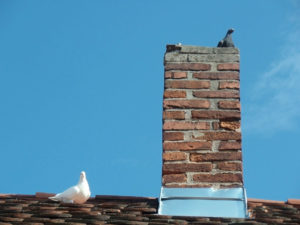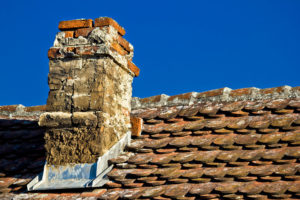When it comes to your home and your chimney, few things are more damaging than water. So if you have noticed signs of a leaking chimney — water or rust in your fireplace, woodstove or thimble, sagging ceilings or stained wallboard adjacent to your chimney, or crumbling pieces of chimney tile in your firebox — you will want to find the cause of the leak fast, before the damage has time to spread. When it comes to a leaking chimney, there are a handful of causes that are usually to blame.
Missing, damaged or displaced chimney cap
 The most important element in keeping water out of your chimney is the chimney cap. Placed at the very top of your flue, the chimney cap shields water from flowing freely down your chimney. If your chimney cap is damaged or missing, water can find its way down into your chimney, where it can damage your chimney liner, wood stove, furnace and rust your damper, fire grate and fireplace doors.
The most important element in keeping water out of your chimney is the chimney cap. Placed at the very top of your flue, the chimney cap shields water from flowing freely down your chimney. If your chimney cap is damaged or missing, water can find its way down into your chimney, where it can damage your chimney liner, wood stove, furnace and rust your damper, fire grate and fireplace doors.
Cracked chimney crown
Your chimney crown also plays a vital role in keeping water from dripping into your chimney. Made from cement, the chimney crown seals the layers of your chimney at the top, from the chimney flue to the exterior walls of the chimney. Like any masonry component, the chimney crown can crack over time, allowing water into the chimney structure. Many chimney crowns are improperly constructed as well. To divert water effectively, chimney crowns should slope down and away from the flue and should overhang the edges of the exterior chimney walls.
Deteriorated chimney masonry
 Masonry materials inevitably absorb water. Every time it rains, snows or sleets, the exterior bricks and mortar of your chimney soak in water. Then, when temperatures drop, that water freezes and expands, causing the bricks and mortar to crack and crumble. If your chimney’s exterior masonry has cracked, it can allow more water to make its way into your
Masonry materials inevitably absorb water. Every time it rains, snows or sleets, the exterior bricks and mortar of your chimney soak in water. Then, when temperatures drop, that water freezes and expands, causing the bricks and mortar to crack and crumble. If your chimney’s exterior masonry has cracked, it can allow more water to make its way into your
chimney, causing damage to the chimney and your home.
Damaged flashing
Flashing forms a tight seal around the base of the chimney, where it meets your roof line. The metal flashing can pull away from the chimney base, crack at the edges or corrode due to age. Failing flashing is one of the leading causes of chimney leaks, and it can allow a devastating amount of water into your home’s structure.If you have noticed signs of a leaking chimney, don’t wait to call the chimney experts at Clean Sweep of Anne Arundel County! Chimney leaks that are left unchecked can cause major damage to your home. Our chimney technicians will inspect your chimney to find the source of the leak and recommend the best course of action for repairs to keep your chimney and your home dry. We also can apply a waterproofing solution to your chimney that will help keep damaging moisture from seeping into your chimney’s masonry and causing water and structural damage.
